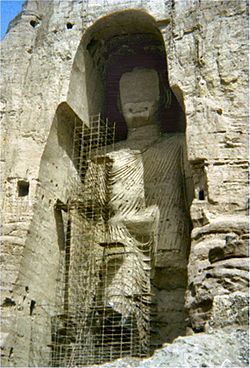Buddhas of Bamiyan
| Cultural Landscape and Archeological Remains of the Bamiyan Valley | |
|---|---|
| Name as inscribed on the World Heritage List | |

The taller of the two Buddhas of Bamiyan in 1976
|
|
| Location | Afghanistan |
| Type | Cultural |
| Criteria | i, ii, iii, iv, vi. |
| Reference | 208 |
| UNESCO region | Asia-Pacific |
| Inscription history | |
| Inscription | 2003 (27th Session) |
| Endangered | 2003–present |
Coordinates: 34°49′55.35″N 67°49′36.49″E / 34.8320417°N 67.8268028°E
The Buddhas of Bamiyan (Persian: بت های باميان – bothā-ye Bāmiyān) were in 4th and 5th-centuries monumental statues of standing buddha carved into the side of a cliff in the Bamyan valley in the Hazarajat by Hazaras region of central Afghanistan, 230 km (140 mi) northwest of Kabul at an altitude of 2,500 meters (8,200 feet). Built in 507 CE (smaller) and 554 CE (larger), the statues represented the classic blended style of Gandhara art. They were 35 and 53 meters tall, respectively.
The main bodies were hewn directly from the sandstone cliffs, but details were modeled in mud mixed with straw, coated with stucco. This coating, practically all of which wore away long ago, was painted to enhance the expressions of the faces, hands, and folds of the robes; the larger one was painted carmine red and the smaller one was painted multiple colors.
The lower parts of the statues' arms were constructed from the same mud-straw mix while supported on wooden armatures. It is believed that the upper parts of their faces were made from great wooden masks or casts. Rows of holes that can be seen in photographs were spaces that held wooden pegs that stabilized the outer stucco.
They were dynamited and destroyed in March 2001 by the Taliban, on orders from leader Mullah Mohammed Omar, after the Taliban government declared that they were idols. An envoy visiting the United States in the following weeks explained that they were destroyed to protest international aid exclusively reserved for statue maintenance while Afghanistan was experiencing famine, while the Afghan Foreign Minister claimed that the destruction was merely about carrying out Islamic religious iconoclasm. International opinion strongly condemned the destruction of the Buddhas, which in the following years was primarily viewed as an example of the extreme religious intolerance of the Taliban. Japan and Switzerland, among others, have pledged support for the rebuilding of the statues.
...
Wikipedia
